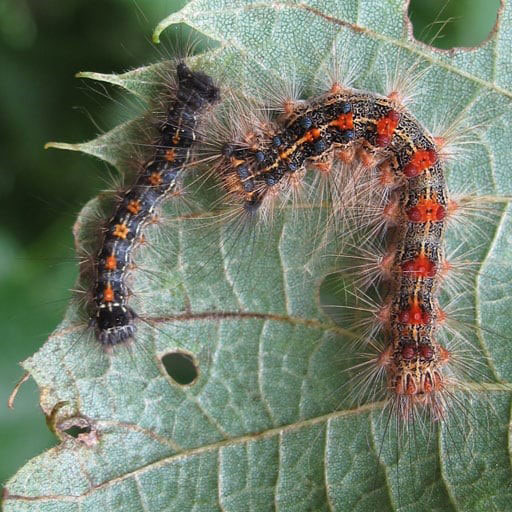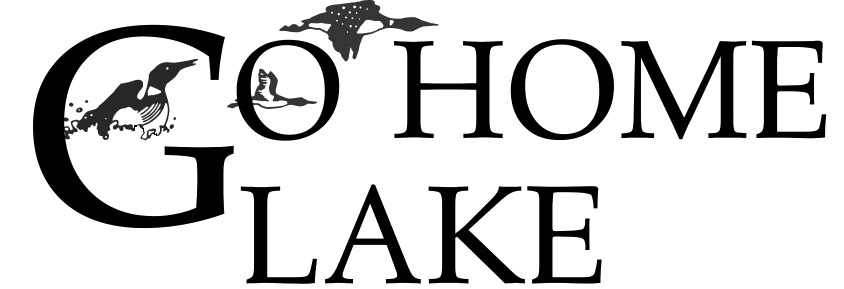Go Home Lake and LDD (Gypsy) Moths
As anyone who visited Go Home Lake in 2021 knows, the LDD (Gypsy) moth caterpillar caused widespread defoliation across the area – causing concern for the health of cottage owners’ oak trees (their preferred diet) as well as most other trees they could devour.
This caterpillar is considered invasive to Southern and Central Ontario’s forests; the moths lay eggs on the bark of trees in the summer which hatch the following spring into larvae which feed on the new foliage. By July, the caterpillars begin their metamorphosis to moths and repeat the cycle.

Outbreaks occur every 7 to 10 years. Outbreaks naturally resolve themselves generally within a few years (see the Natural Controls section below). During severe outbreaks, trees and shrubs may become completely defoliated. Despite the tree’s ability to produce a new crop of leaves over the summer, the damage can have longer term impacts, as defoliation can make trees more susceptible to secondary pests, drought, and poor growing conditions.
The Go Home Lake Cottage Owners Association shares everyone’s concerns with both controlling the damage caused by LDD moths as well as minimizing any secondary environmental impact related to controlling their population.
The Association’s Board of Directors has decided we will provide information to inform cottagers regarding methods to control the potential return of the caterpillars in 2022 but not make recommendations. The board recognizes that each property is maintained by the property owner and their right to maintain it responsibly.
Control Measures for Managing LDD Outbreaks on your property
There are different methods of managing and limiting the impact of an LDD outbreak. They range from caring for individual trees using natural procedures and solutions to aerial spraying. The GHLCOA does not recommend nor attest to the safety or effectiveness of any one solution.
The control measure depends on the timing in the moth’s lifecycle:
August to mid-April Remove egg masses and discard. Option to have onsite egg mass survey completed to ascertain risk for the coming year. Mid-April to mid-May Option to apply biological pesticide (see later section) Mid-May to June Attach burlap bands and discard larvae June to mid-July Remove pupae by hand and discard July to August Adult moth is short-lived; focus on other stages
Natural Controls
Natural predators and pathogens are the main reason the LDD moth outbreak in North America is collapsing.
Nuclear polyhedrosis virus (NPV)
- NPV is a viral infection known to kill LDD moth larvae once the virus builds up in a population.
- It can spread quickly from infected larvae to non-infected larvae, killing them.
- Dead larvae hanging on a tree in an upside-down “V” is a sign that the virus is at work in the population.
Entomophaga maimaiga
- A fungus known to cause LDD moth populations to collapse.
- Cool, wet conditions provide an ideal environment for the spread of this fungus.
- Dead larvae hanging vertically along tree trunks that appear brittle and desiccated is a sign that this fungus has killed gypsy moth larvae.
Predation and parasitism
- Birds, mammals and other insects are known to prey on gypsy moth.
- A species of wasp called Ooencyrtus kuvanae is known to parasitize gypsy moth eggs and can reduce gypsy moth populations.
Cold weather
- Extended days of extreme cold (−20 degrees Celsius) may kill overwintering larvae in exposed egg masses.
Chemical Controls
There are a few government regulated/approved chemicals that are used to control LDD moth outbreaks. These include TreeAzin® (injected into the tree), Gypchek, BTK, Foray 48B (used in aerial spraying). Information about the use, effectiveness, and concerns regarding chemical spraying is available from a number of sources on the Internet.
Learn More about LDD moths and the impact of chemical control measures
Before deciding on a chemical control, please review current information about the outbreak as well as the concerns regarding BTK insecticide. Here are some useful articles and websites:
- https://www.invasivespeciescentre.ca/invasive-species/meet-the-species/invasive-insects/gypsy-moth/
- FOCA: LDD Moth
- Gov’t of Ontario: LDD Moth Information
- Leave the gypsy moths alone, says entomologist | Wiarton Echo
- Why an invasive moth caterpillar infestation is breaking records in central Canada | CBC News
- As cities panic over a gypsy moth invasion, Ontario’s Pinery park tells visitors to ‘roll with it’ | CBC News
- 2020’s Invasive Moth Disruption – Ontario Nature
- Gypsy moths have started hatching in Waterloo Region, and this year they could do severe damage | TheRecord.com
- The very hungry caterpillars (ontarioparks.com)
- The BTK insecticide used for LDD moths puts at-risk species in danger. Luckily, an alternative exists | The Star
- Natural Enemies of Gypsy Moth: The GoodGuys!
- BTK spray kills native butterflies, moths, imperils nestlings – Return of the Native Hardy Perennials
LDD moth Aerial Spraying on Go Home Lake in 2022
A number of GHL cottagers have asked for information about aerial spraying in 2022. Aerial spraying uses a chemical called Foray 48B which is comprised of BTK.
One Ontario company is offering this service in our area. For those who are interested in pursuing this control measure can follow the procedures in this communication from Zimmer Air:
Thank you for your contacting us about the 2022 gypsy moth control program. I am excited to announce that applications for the 2022 spray seasons are now being accepted. This year’s program will be organized by the Ontario Centre for Defoliator Control. This company will be your go-to for all your gypsy moth-related inquiries for the 2022 season. You can find the application on their website: www.ocfdc.com. Once the application has been submitted, one of the OCFDC representatives will begin mapping your property and follow up with all the necessary information about the coming year’s program. Please be patient as the list of people interested in the program is extensive and may take months to process all of them. Once the OCFDC representative has established the property lines, they will distribute the service agreement, waivers, and payment form with pricing for spraying your property. Thank you for your continued patronage, we look forward to another successful season.
Chris Bell Zimmer Air Services Inc 9742 Burk Line Blenheim, On www.zimmerair.com




